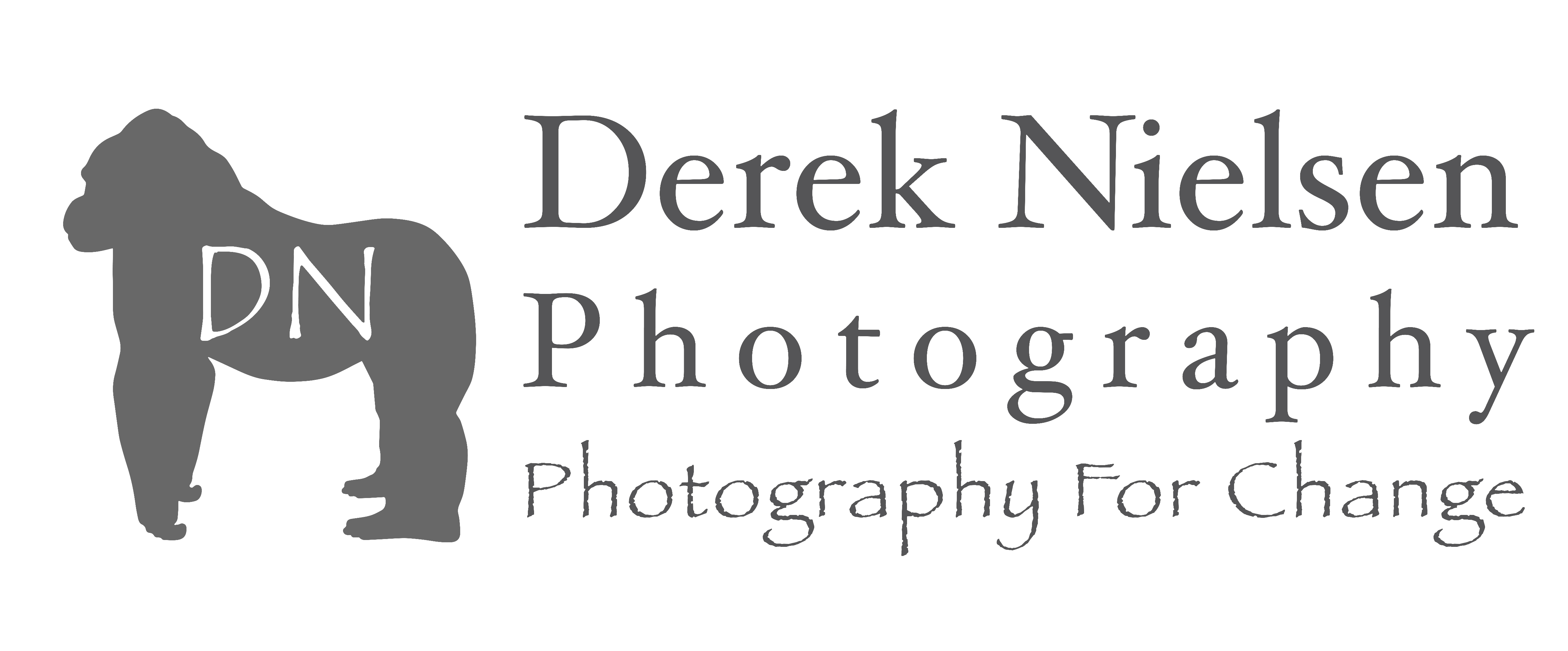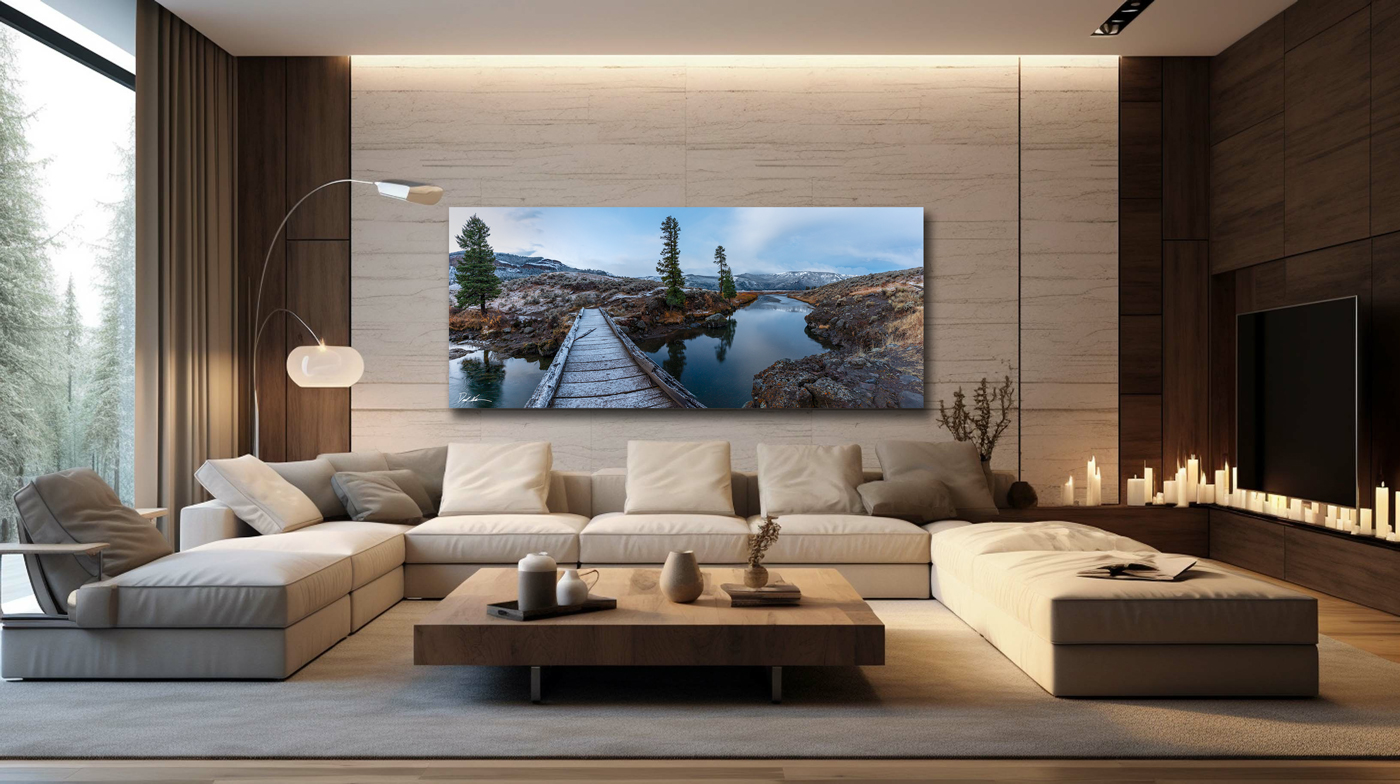
Fine art landscape photography and other two-dimensional wall art can completely transform any room. We spend most of our time inside our homes or offices; nothing is less stimulating than a blank white wall. Some of us don’t have the eye for design or the time to execute our vision. Interior designers are magicians at turning the ordinary into the extraordinary. Not all of us can afford to work with an interior designer, but by using this guide, you can transform your space with intention.
Choosing a design for your room.
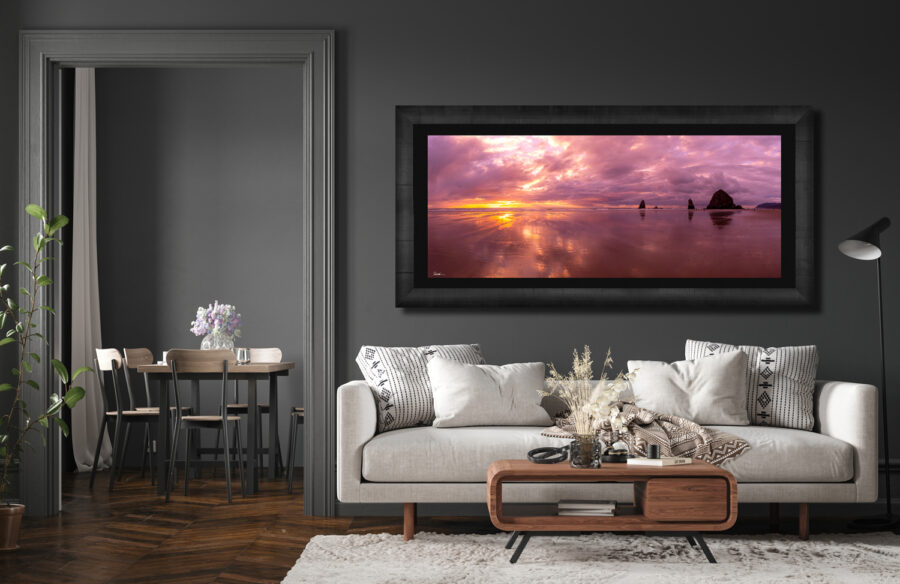
The hardest part about choosing a design is sorting through all the options. It can become an option overload. The most important thing to remember is that if it makes you happy, then nothing else matters. It is your space. Don’t design something for your judgy neighbors or crabby in-laws. It is not their space, and it’s none of their business.
Things to consider when choosing an interior design.
- What colors are you drawn to?
- Is there a theme or concept you want to stick with?
- What is your budget?
- What kind of light is available in the room? Natural vs. Artificial.
- Is form or function more important?
Choosing the best elements for your design.
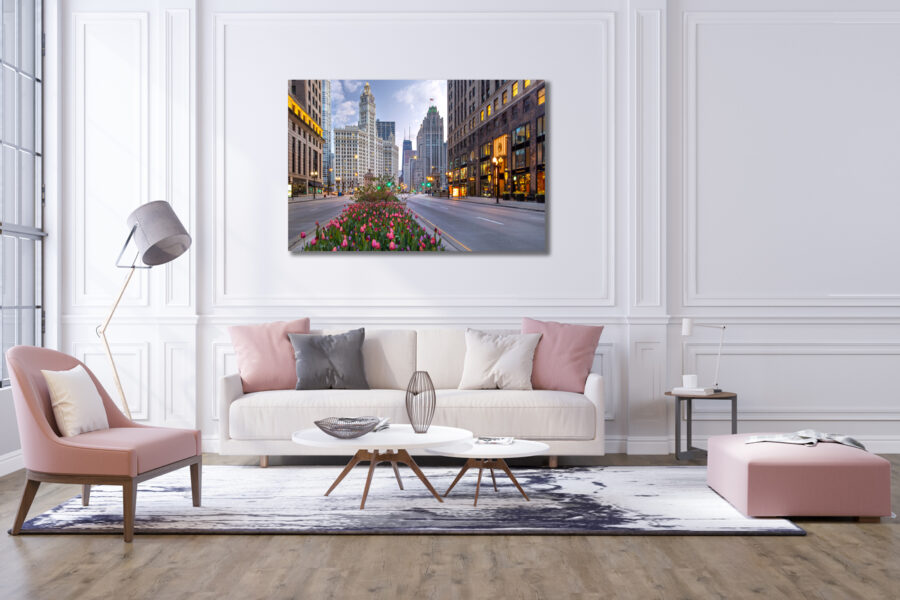
Every room will have its obvious focal points. A bedroom is built around the bed. A dining room is built around the dining room table. Take time to think about the room you’re designing and work outward from the key element. For this example, let’s focus on the living room. This is the most used space in most households. Experts can agree seating for this room should be the priority. Spend extra time and, if need be, money on the perfect couch or chairs, then work outward. Next, pick accent pieces like rugs, pillows, and decorations that complement the main design elements. Finally, fill the blank walls with art.
As a lover of the outdoors and a fine art photographer, it is an easy choice for me. I prefer to use large-format prints to fill the big blank walls in a home. The beautiful thing about landscape photography is it comes in such a wide range of colors and styles. Nature prints really can fit any design.
Fine art landscape photography for interior design.
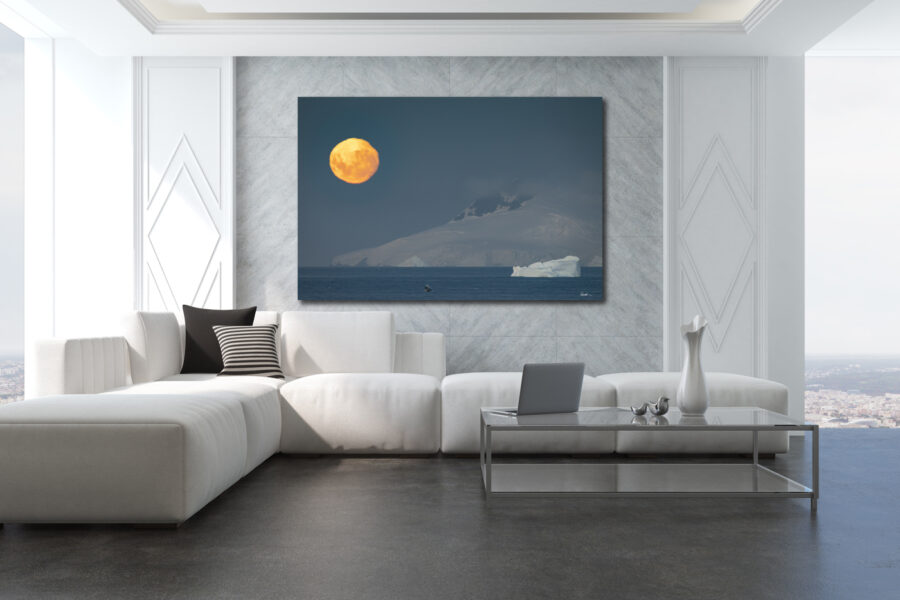
Fine art landscape photographs are the number one selling subject matter purchased in photography worldwide. Landscape images are versatile, typically unoffensive, calming, and trigger positive emotion. They make a great statement piece in any room or design option. Human beings receive a calming effect when looking at a natural landscape, such as flowing water or an untouched forest. A landscape image creates an open door to nature right from your own living space. Bringing elements from the natural world into our design can have larger effects than just a pretty picture on a wall.
Tips on choosing the right photograph for your design.
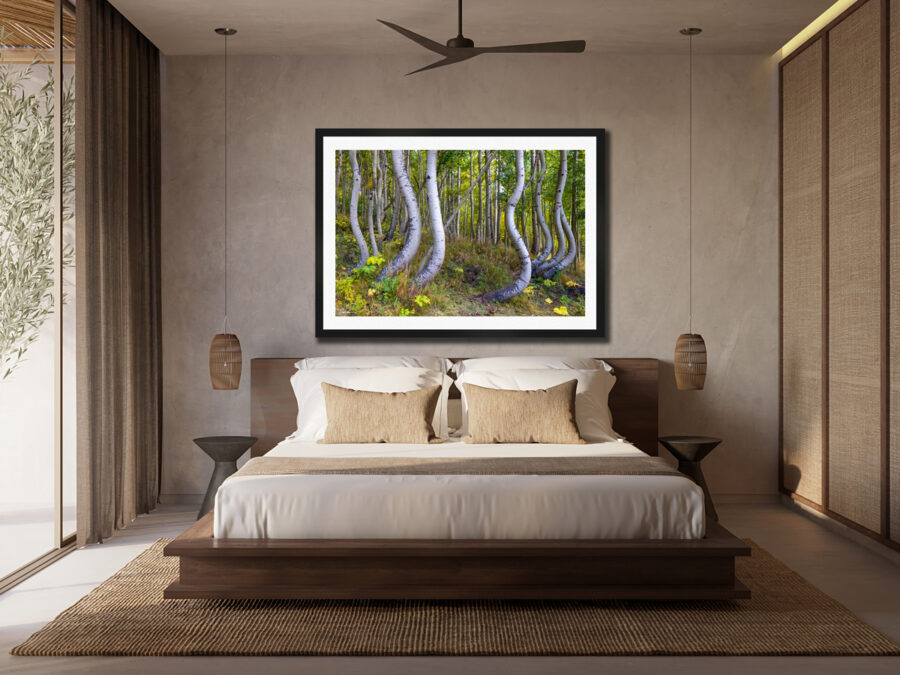
Ok, you have taken on this new home project, but how do you choose the right photo for the space? Thankfully, with technology, creating an image mockup is an easy option. This allows you to see the fine art print on the wall before committing. Digital mockups are also a great way to get a better feel for scale. As with any piece of art, a fine art landscape print should speak to you in some way. This image will likely be the focal point of your room, so pick a scene that inspires you, relaxes you, or brings back great memories.
Choose the right photograph size for your wall.
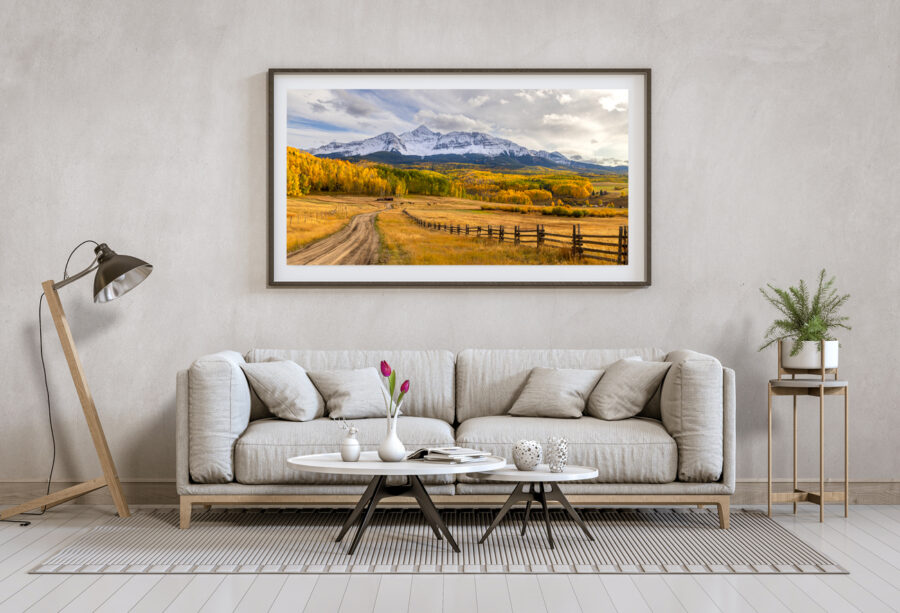
Very seldom do you see a fine art photograph too large for a wall, but we often see high-quality images printed too small for the wall they are on. Here are some general rules to live by, but as always, rules are meant to be broken.
- Art above a couch or bed – a photograph should cover 6/10(.6) to 3/4(.75) the size of a wall or the size of the furniture it will be displayed above. For example, if you have a 96″ couch, multiply 96 by .6 to get the smallest your work of art should be. Likewise, multiply 96 by .75 to get a rough idea of the largest it should be. In this case, your photo should be between 58″ and 72″ wide.
- Art above a fireplace – the work of art should be about the same size as the fireplace’s opening.
- Art on a blank wall – the three-eighths rule gives you a rough estimate. Multiply the length of your wall by 3/8 (.57). On a 9-foot wall, a print of 60 inches will look best.
- Height of your print – Art should be hung 58 inches from the center of the work to the floor. It should not be hung at eye height because this is different for everyone. If it is off the back of a headboard or couch, it should be no more than 8-10 inches higher than the back of the furniture.
How to light your fine art landscape photography.
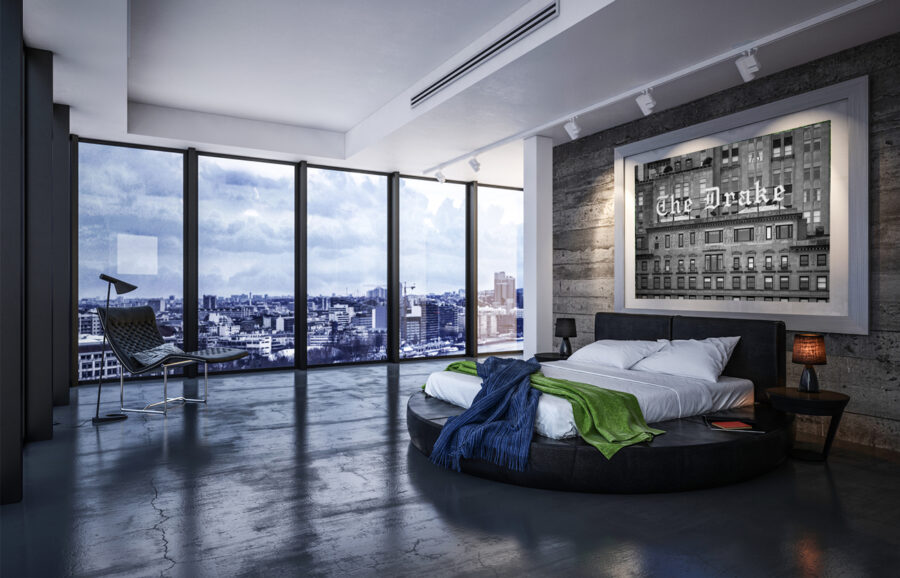
Lighting is one of the most important decisions for your interior design or home remodeling project. During the daytime, we have the luxury of natural light entering the room. At night, your light choice can be everything.
As a professional photographer, I get great satisfaction from seeing one of my prized fine art nature photography prints perfectly hung and lit in someone’s home. Conversely, seeing it with a damaging ultra-bright white light breaks my heart. Bright, cool white light is great for a hospital or office but makes a home feel sterile.
(As a side note: your lights should not blind you or your guest. Edison lights or exposed bulbs can be very distracting if not used well.)
Artificial lighting comes in a wide range of color temperatures. Products like Phillips Hue lights take that statement to another level. Please don’t go through the trouble of perfectly designing your home only to wreck it with offensive light fixtures or cold daylight artificial light. Pick a light temperature close to 3000-3500K. This gives the room a soft, inviting, warm glow, bringing out the warm tones in your design without changing the look of the art.
Working with different color palettes.
Have you ever noticed how specific colors make you feel? How about how certain colors look good together while others seem to clash? It turns out there is more to color than meets the eye.
Psychology of color.
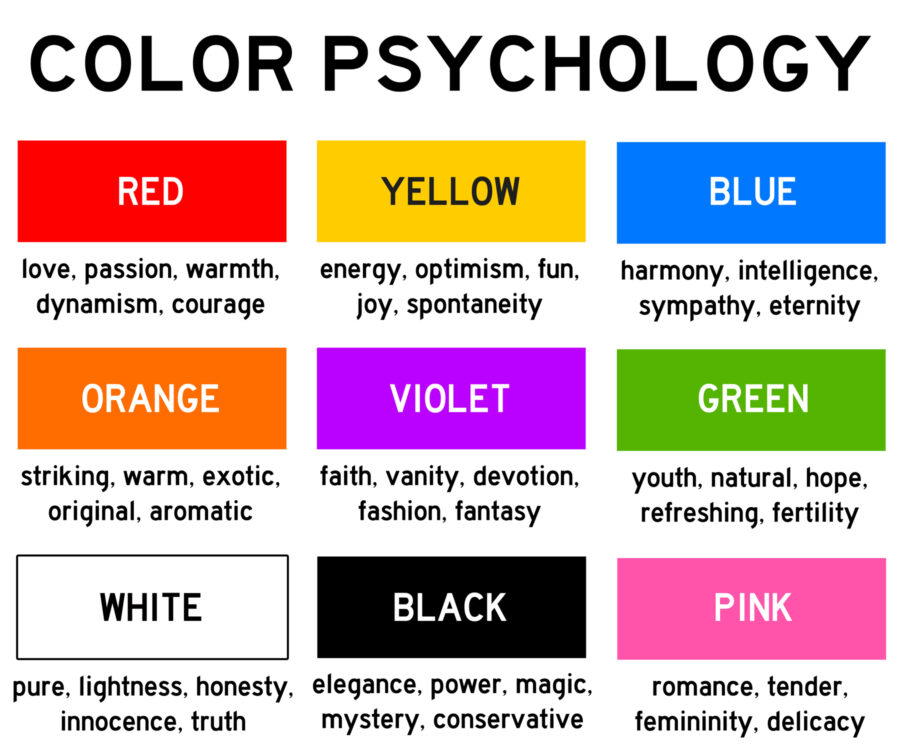
A color palette sets the entire mood of the room. Bright colors create an entirely different set of emotions than dark ones. Even the colors themselves make us react differently by nature. I won’t go into color theory in depth in this article, but you should at least be a little familiar with it before diving into a design. Here, I will show you how specific colors affect our mood.
- Blue – Blue is the most preferred color in the world. Blue brings out feelings of calmness, peace, and relaxation. It also has a physiological effect on our bodies, lowering our heart rate and blood pressure.
- Green – Green is one of the most common colors found in nature. It has a psychological effect of calmness, healing, and positivity and lowers stress.
- Red – Red is the color of passion. It brings out emotions of power, desire, and excitement. Red brings out feelings of caution and has been shown to raise our heart rate.
- Brown – Brown is a friendly, earthy organic color. It is associated with strength, resilience, and safety.
- Gold – Gold and yellow cast a warm, soft light in any room. Gold is often connected with feelings of luxury, knowledge, and generosity. Gold creates feelings of happiness and euphoria.
Color theory and harmony.
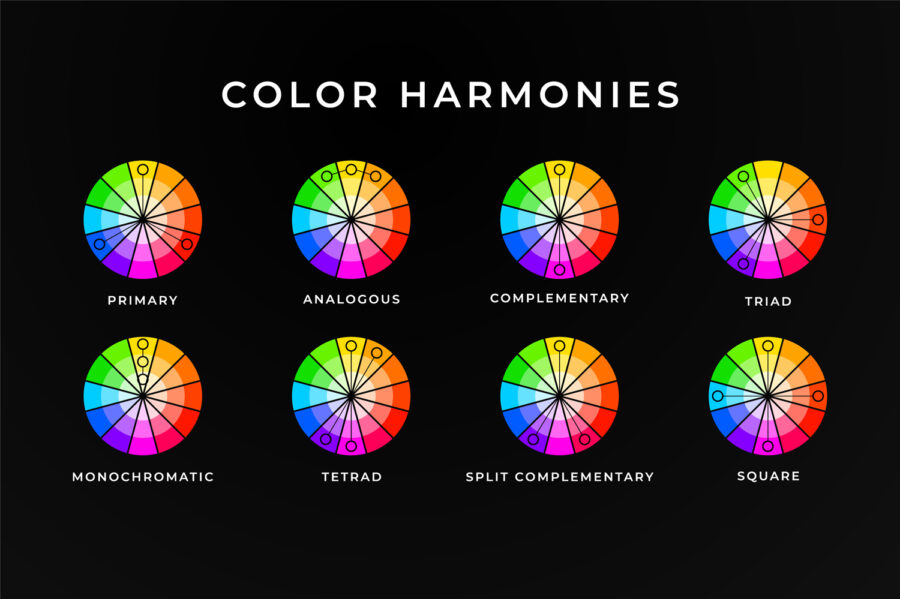
When colors work together in a comfortable or soothing way, we call this color harmony. It is a good idea to look at the color wheels above to better understand how colors work together. Let’s start with the “Primary Colors“: Red, Blue, and Yellow. These three colors, when blended, form the remainder of the colors we see in our visual spectrum. Take your time to explore the different relationships each variation offers. See if you can spot them in your design or in the designs shown in this article.
Making colors work in your home.
If you already have an expensive sofa or favorite rug you can’t part with, choose a fine art landscape photo that works with your furniture. Make your room as cohesive as possible by using the color harmony models provided above. Use an accent piece to pull in different colors found throughout the room and in the photo. Using multiple pops of color from throw pillows or candles is an easy and inexpensive way to build color harmony in your design.
Fine art landscape photography in an office space.
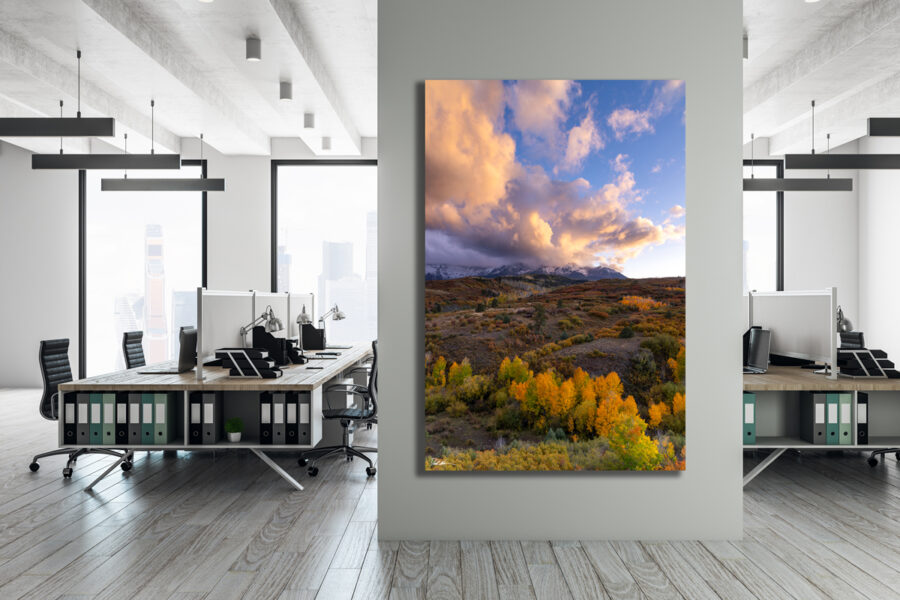
Interior design is not limited to our homes. Offices, hotels, restaurants, and many other businesses hire design experts to help create an inviting interior. Our surroundings have such a significant impact on our mental health, affecting things like productivity and motivation. Many businesses select original artwork, typically something limited edition, to avoid having the same design as their competitors, confusing potential clients. It is time to get rid of those awful motivational posters with a stock image on them. You know exactly the ones I am referring to.
Why luxury fine art photography works best for interior design.
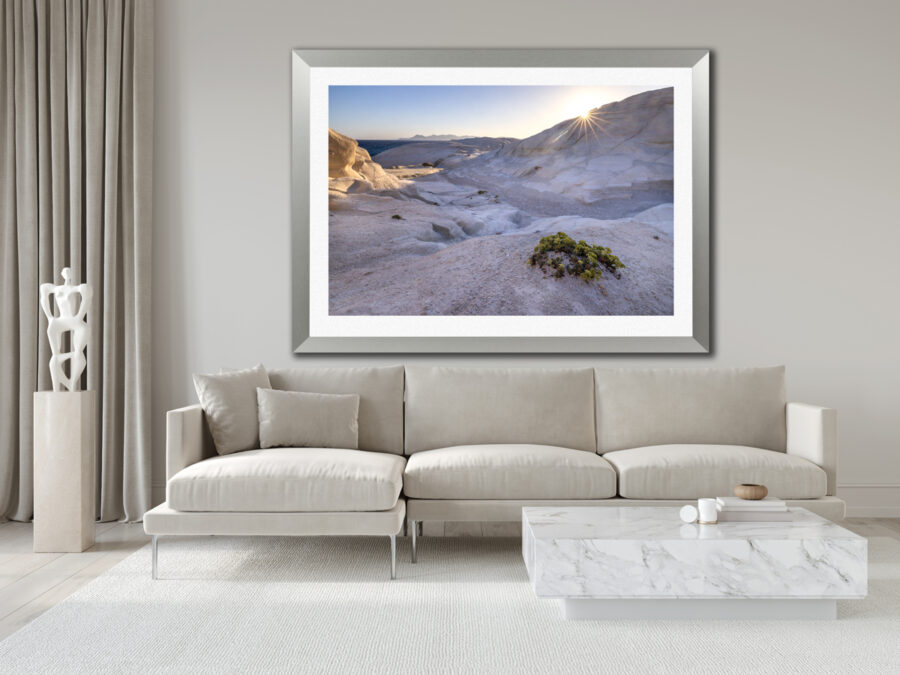
When strictly speaking in terms of high-quality interior design context, an important consideration should be placed on the most significant design elements. Spending money on a beautiful couch or dining room table only to accent it with budget art will send a confusing message to your guest. Lumachrome acrylic prints pop in any room and are the best way to make your artwork stand out. The vivid, bright, crisp colors really pop, helping complete the look you are going for. Let’s take a look at the history of interior design and learn about some of the best to ever do it.
The history of interior design.
Decorations such as sculptures, pottery, or wall paintings were used by ancient civilizations as early as 20,000 years ago. Most served a functional purpose other than ascetics alone, such as storytelling. It was not until the Renaissance period that an emphasis was placed on lavish design elements such as furniture, paintings, drapes, and carvings for ascetics. Before this period, much of what people possessed was not worth protecting and usually served only a functional purpose.
The Industrial Revolution and the birth of interior design as a profession.
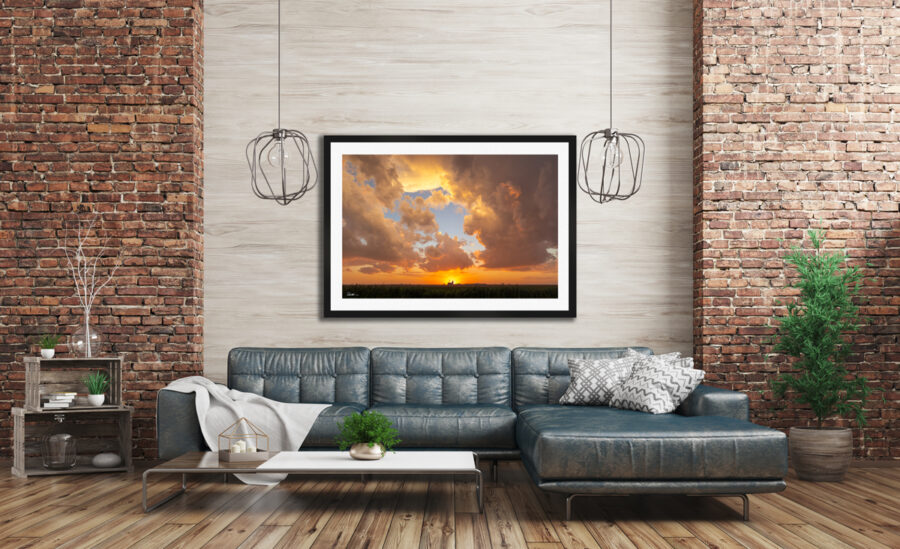
During this period in time, materials like glass, steel, machine-made furniture, and machine-made decorations were becoming readily available to the general public. Items like rugs, wall coverings, and lighting began taking much less time to produce. Interior design as a separate profession was born. Most “decorators” at this time had no credentials, only a good eye and a reputation. In 1906, the first interior design schools were established.
Elsie de Wolfe, America’s first interior decorator.
Elsie de Wolfe cemented herself as the first interior decorator after receiving a commission to decorate the Colony Club in Manhattan, an elite women’s only social club. Also known as Lady Mendl, Elsie de Wolfe despised the heavy, dark tones of Victorian design. In turn, her designs preferred lighter, brighter color schemes. She authored several books, including the first-ever book on interior design named “A House In Good Taste.” Her long career working with society’s distinguished members paralleled her own fame.
Most influential interior designers.
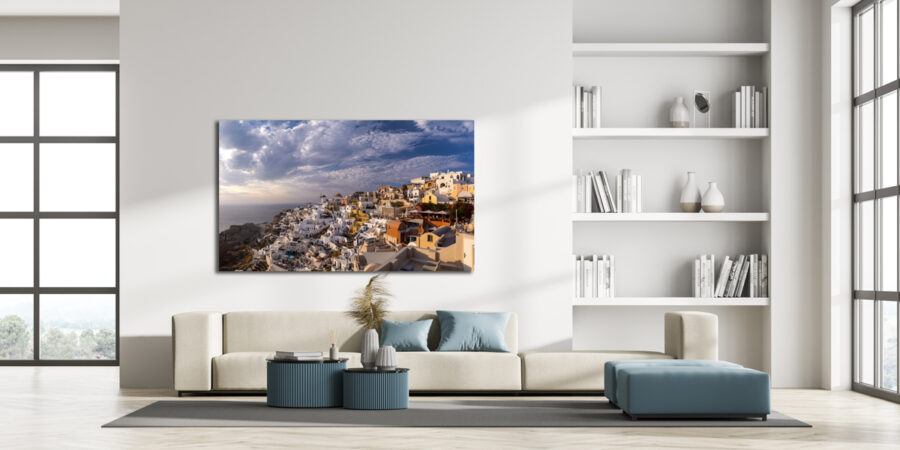
While Elsie de Wolfe opened the door for so many, these other designers also made a mark on the field with distinguished careers.
- Jean-Michel Frank – Furniture designer who made luxurious pieces for Hermes as well as one of the most celebrated designers of the 1930s. Inventor or the Parsons Table.
- Sister Parish – Credited with creating the American Country look, Sister Parish famously redesigned rooms in the White House during the Kennedy administration.
- Albert Hadley – Known as the “father of transitional design,” Hadley worked alongside Sister Parish designing for both Kennedy’s private homes and living quarters in the White House. His style mixed glamorous with functional.
- Dorthy Draper – Author of “Decorating Is Fun,” Draper was known for her bold use of colors and patterns in a boldly fearless way.
- David Hicks – Launched his career by making over his parent’s home in a magazine. Hicks wove stark patterns into his designs using wallpapers he personally crafted and eventually sold across eight countries.
- Billy Baldwin – A master of more than just decoration but the use of space, Baldwin was famous for accentuating the architecture of a room with functional comfort.
High-quality fine art landscape photography completes any interior design.
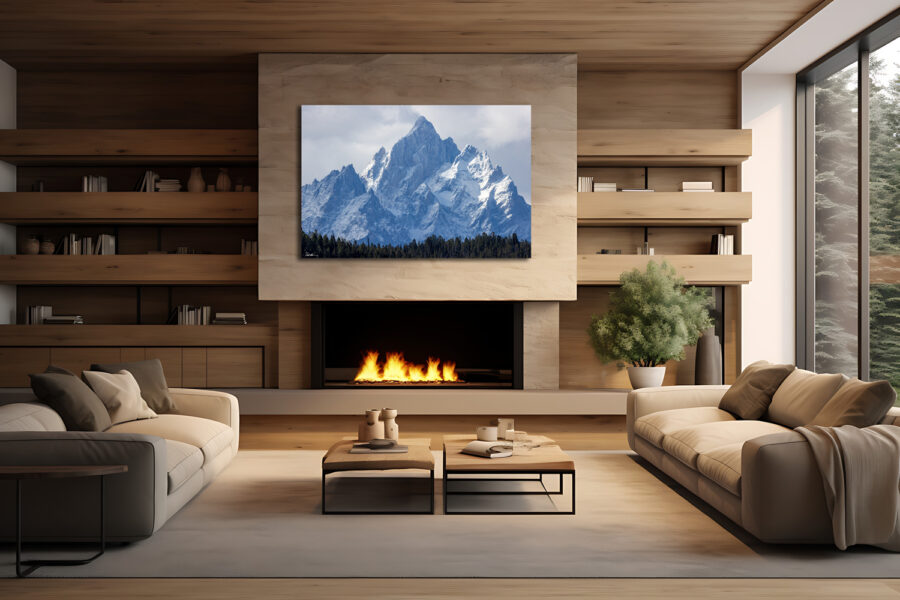
Humans have a primal connection to nature. When we strip away all our possessions, we are as much a part of nature as the wild animals roaming the planet. Creating an inviting interior design around natural elements found in landscape photography shows an organic sophistication. Having the freedom to choose your color harmonies, set your own theme, and accent pieces allows you to create a sanctuary inside your home that is both calming to you and inviting for your guests. Interior design is fun. Don’t get caught up in the need to use every new trend on HGTV. We have all been guilty of buying that “Live, Laugh, Love” sign from a home goods store. As cute as some of the generic signs are, try upping your design with fine art landscape photography to really bring your room to the next level.
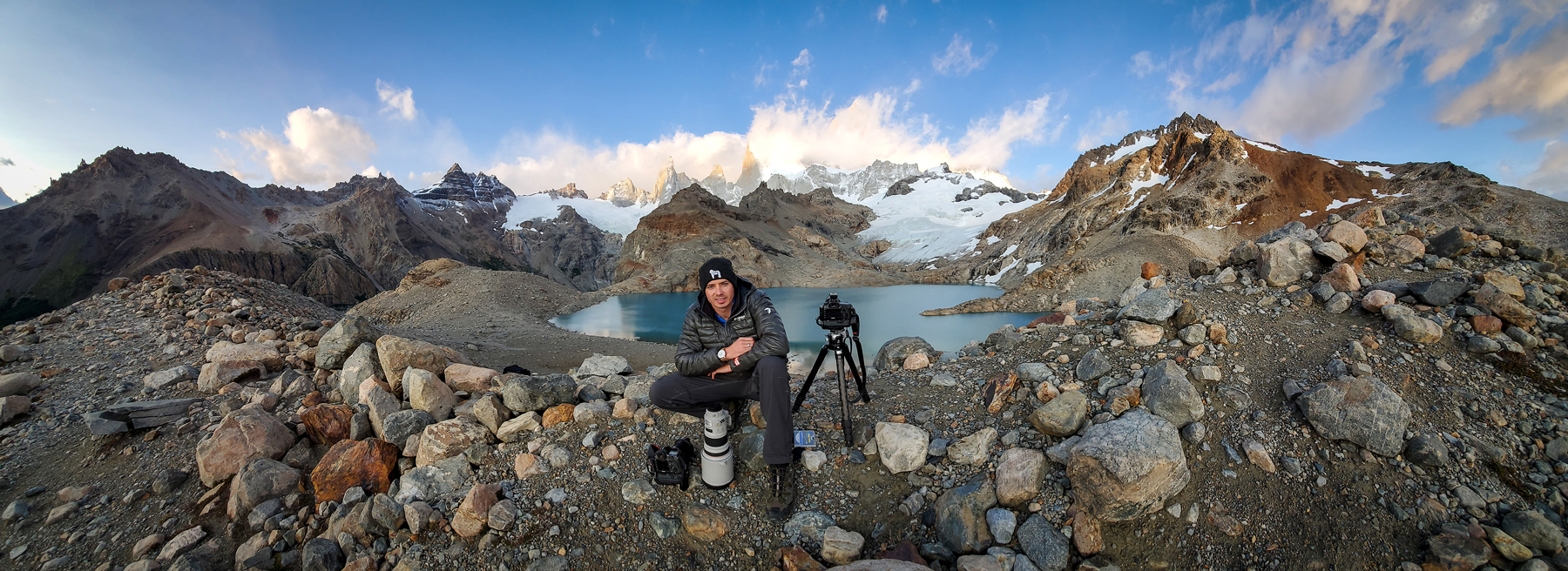
Hello! I'm Derek.
DEREK NIELSEN PHOTOGRAPHY RAISES AWARENESS ABOUT THE GLOBAL NEED FOR CONSERVATION THROUGH PHOTOGRAPHY AND DONATES UP TO 15% OF ALL SALES BACK TO ENVIRONMENTAL ORGANIZATIONS AROUND THE WORLD.
